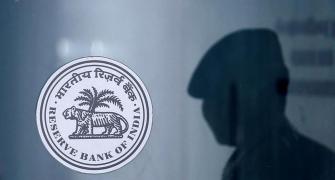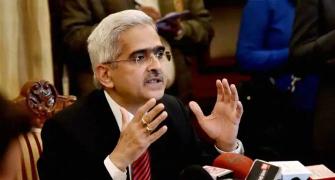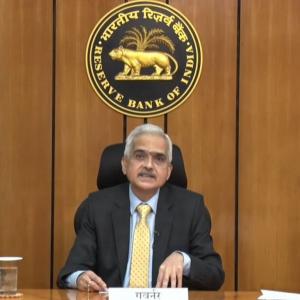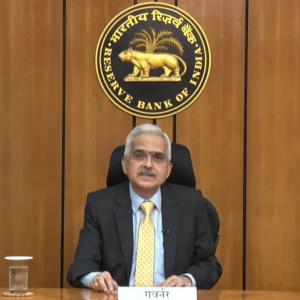In its scheme of things, tackling inflation now comes ahead of ensuring growth in the world's sixth largest economy, points out Tamal Bandyopadhyay.

For the record, the Monetary Policy Committee, the Indian central bank's rate-setting body, at its last meeting left the key policy rates -- repo and reverse repo -- unchanged, at 4 per cent and 3.35 per cent, respectively.
For the 11th consecutive time since May 2020.
The Reserve Bank of India absorbs liquidity from the banking system at reverse repo rate and infuses it at repo rate.
It also left the monetary policy's stance unchanged -- accommodative.
Finally, the RBI raised its inflation forecast and pared forecast for growth for the year. While the average inflation forecast for FY2023 was raised by 120 basis points (bps), from 4.5 per cent (estimated in February) to 5.7 per cent now, the forecast for growth was cut by 60 bps, from 7.8 per cent to 7.2 per cent. One bps is a hundredth of a percentage point.
So, the narrative is fairly simple. Right? Wrong. The key takeaways from the policy, the first in the current fiscal, are very different.
The reverse repo rate, which had already been made redundant to some extent with the introduction of variable rate reverse repo or VRRR auctions in the recent past, has now been given a decent burial. This is being done by way of introducing another instrument to absorb excess liquidity from the system.
Almost eight years after the Urjit Patel Committee had recommended a new tool, christened Standing Deposit Facility (SDF), to absorb excess money by the central bank without offering any collateral to the banks, the RBI has put it in place.
The SDF rate is fixed at 3.75 per cent, 40 bps over the reverse repo rate and 25 basis points below the repo rate.
While VRRR auctions may continue to absorb excess money for a fortnight or even longer, SDF is the window for draining out overnight money. Simply put, the RBI has raised the rate without raising it.
Sounds like a riddle? Well, the SDF rate, 40 bps higher than the reverse repo rate, will now be the floor of the liquidity adjustment facility or LAF corridor.
With its arrival, the corridor has been narrowed to the pre-pandemic level, without tinkering with the reverse repo rate.
The width of the corridor is restored to 50 basis points, with SDF (3.75 per cent) as the floor and the Marginal Standing Facility or MSF (4.5 per cent), the rate at which the RBI lends money to banks, as the ceiling.
This will push up the short-term rates (which has already been done to some extent through the VRRR auctions). The overnight call money rate is expected to move between 3.75 per cent and 4.25 per cent.
This is not the only riddle in the policy. There are more.
The stance of the policy remains 'accommodative', but look at the guidance. What does it say? 'The MPC ...decided unanimously to remain accommodative while focusing on withdrawal of accommodation to ensure that inflation remains within the target going forward, while supporting growth.'
One cannot quibble with central bank-speak but the stance has clearly shifted. Even though the RBI has not officially admitted it, the move is towards neutralisation.
In fact, at the post-policy interaction with the media, RBI Deputy Governor Michael Patra highlighted that the ultra-accommodation' is being removed and the process of moving towards positive real rates has started.
Can we expect the RBI to be more explicit?
Why is this a withdrawal of accommodation? Well, there is a big shift in the Indian central bank's approach to monetary policy. In its scheme of things, tackling inflation now comes ahead of ensuring growth in the world's sixth largest economy.
Look at the change in the language.
Two months back, in February, the RBI had said, 'The MPC also decided to continue with the accommodative stance as long as necessary to revive and sustain growth on a durable basis... while ensuring that inflation remains within the target going forward.'
What did it say four weeks ago? 'The MPC also decided to remain accommodative while focusing on withdrawal of accommodation to ensure that inflation remains within the target going forward, while supporting growth.'
I wonder why the RBI didn't raise the reverse repo rate instead of killing it. Probably, to convince the market about gradualism -- nothing will be done in a hurry.
After all, it needs to ensure a record high government borrowing during the year. But the market was not exactly convinced. The 10-year bond yield breached the 7 per cent level to touch 7.12 per cent, last seen in May 2019 when the repo rate was 6 per cent.
The market expects multiple rate hikes in the coming months and the repo rate to be at around 5 per cent by the year-end.
The RBI's Monetary Policy Report, released along with the policy, speaks about core inflation remaining at an elevated level of 6 per cent, at the upper end of the inflation target band (4 per cent +/- 2 per cent), and the impact of the Russia-Ukraine conflict not only on crude and other commodity prices but also on food inflation. It also talks about a high level of inflation in FY24.
RBI Governor Shaktikanta Das has clearly stated that future policy actions would respond to a dynamic and fast-changing world. In other words, the actions will be data-dependent.
While it's certain that a tight money policy is staring at India, the pace of the rate hike and its quantum cannot be predicted at this point.
Can the RBI start raising rates while withdrawing accommodation but not changing the stance to neutral? That's also possible. Patra has spoken about moving to positive real rates. Technically, till we have a positive real rate, the stance can remain accommodative, and yet rates can be hiked.
The RBI's average inflation projection for the year, at 5.7 per cent, is definitely more realistic than its February projection but a few analysts say it could inch towards 6 per cent. Even at 5.7 per cent, it is some distance away from reaching positive real rate.
Whether the RBI will start raising rates while withdrawing accommodation (and not explicitly changing its stance) is something to watch out for but a formal rate hike is not far away. That's a reality and the Indian central bank is not in a denial mode. Despite there being no rate hike, formally, there could not have been a more hawkish policy.
This column was written before RBI Governor Shaktikanta Das's announcement on May 4, 2022.
Tamal Bandyopadhyay, a consulting editor with Business Standard, is an author and senior adviser to the Jana Small Finance Bank Ltd.










